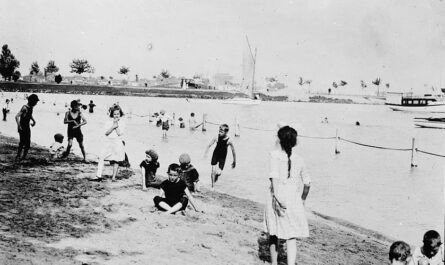The Development of Its Early Roads and Cass City
by Mark Putnam
How Elkland Got Its Name
In Tuscola County, near the headwaters of the Cass River and the fork of its north and south branches, lies today’s Township of Elkland, Michigan.
It was so named because, early on, it was a vast area in the Thumb of Michigan that supported herds of elk that were in great numbers.
At the time of the arrival of European Americans, also lived here many moose and bear in this wonderful timberland.
This was the favorite place of Indigenous hunters.
Nature’s bounty here included beech, maple, elm, basswood, and hemlock trees near the Cass River, and on the north ridge stood majestic stands of white pine trees that grew in great quantity.
On the ridge, the land is sandy and gravelly.
In 1889, in a poem about the landscape of the Saginaw Valley fifty years earlier in 1839, Judge Albert Miller of Saginaw wrote:
“And as we pass on to the river’s head,
We find where the elk and moose are fed.”
From the abundance of elk, the land received its name as we note!
James Baldwin — The First Land Buyer
James Morgan Baldwin made the first purchase of land in Elkland in Section 26 in July 1850.
Later a second purchase, he made in Section 32 in May 1851.
These tracts were near and on the Cass River.
Mr. Baldwin and his wife Antoinette moved to Tuscola County early in 1851.
In May 1851 through August 1854 Mr. Baldwin purchased many large tracts of pine timberland in various townships throughout Tuscola County.
These were primarily between what became Ellington and Elkland Townships and were on the Cass River.
In some purchases, he shared title with David Slafter and Joshua D. Smith who likewise were deeply involved in pine timber real estate and lumbering.
Baldwin lived in Vassar from where he performed his pineland investing.
William McKie — The Thoughts of a City Began
Following Mr. Baldwin was the next purchase of land.
It was for speculative purposes in Elkland.
William McKie in July 1851 made purchases in Sections 27 & 28 that were about a mile back from the Cass River.
In these two sections, the north part of the future town of Cass City would be built.
These tracts would have been logged by the Cooper & Wright Camp that located nearby and whose owners were from Salem, New York.
William McKie was a member of a wealthy family that was initially involved in farming, and that also was from Salem, New York.
McKie likewise purchased tracts of land in Sections 33 & 34 that would become the south part of Cass City and that included today’s Center Creek that emptied into the Cass River.
The State Road would be built west and east through the middle of the McKie tracts.
William McKie saw something here in these properties that were wonderful.
In the landscape, he saw something exceptional.
This point near the Cass River was a perfect locale for a lasting community.
McKie’s purchases would be the foundation of today’s Cass City.
Elkland was a Fantastic Pine Timberland
Elkland’s proximity to the river, its easy access to pine timberland, and its Center Creek made Elkland a source of wealth when lumbered.
The pine timber here, when chopped and cut into logs,, could be run or floated down Center Creek to the Cass River where the logs could be floated further down the river and boomed and drawn into sawmills—it was a grand lumbering area.
The Cass River flowed through the south portion of Elkland.
Center Creek was deep and wide enough during the spring flood to float pine logs in the west portion of Elkland.
With the falling of the pine timber, the wealth of the area would be realized and revealed.
Because of its distance up the Cass River, Elkland was logged later than the west portion of the County of Tuscola.
David Ward — Speculator and Pine Looker
The Pinelands above the Fork in the Cass River were harvested last.
However, with foresight, tracts were purchased early on by David Ward, who was a pine looker.
Hearing of the great stands of pine near the Cass River, a plan by Mr. Ward to make himself wealthy was cast.
In 1852, in the early spring, Mr. Ward left home in Port Huron to explore the forests near the Fork in the Cass River.
Impressive tracts lay near the river and close to the Tuscola border with Sanilac County.
The spring rain was heavy, and with the melting snow, the streams were high, and the swamps were filled with water.
In January 1854, Mr. Ward made purchases of pine timber tracts in Elkland in Section 1 near the Cass River and in 5 and 8 above the swamp and headwaters of Center Creek.
Later, logs from Sections 5 and 8 likely skidded or floated through the northwest Elkland swamp and down Center Creek.
This may have occurred when the Cooper & Wright Camp was just past its peak.
Cooper & Wright Camp
Who essentially were the first pioneers of Elkland?
History tells us that they were the lumbermen Hugh McFaddon and Z. Washington Wright and their “shanty boys.”
The Cooper & Wright Camp brought in many who became pleased with the character and fertility of Elkland.
Many of the early pioneers came first as shanty boys.
They logged the area and were enamored by the land, so they were located here, making for themselves homesteads.
Many of Elkland’s early pioneers as shanty boys worked in the winter with the Cooper & Wright Camp, and in the nearby woods, they chopped or felled timber, sawed them into logs, and stacked them at rollways on Center Creek or the Cass River where the logs waited for the spring freshet or flood when they would be floated down to sawmills on the Cass or Saginaw River.
The shanty boys who became the local pioneers cleared and farmed their own land in the summer.
In this way, shanty boys established homesteads.
Washington Wright purchased three pine tracts on Center Creek in Sections 20, 28, and 29 in 1855 and 1856, tracts that would include the Cooper & Wright Camp.
Cooper & Wright likely began logging in the winter of 1855.
With the sound of axes, saws, and the yell of timber, the woods then came alive.
Proud they were to put at the log’s end the Cooper and Wright brand or stamp.
Mr. Wright’s associate, Hugh Cooper, and his cousin Alexander P. Cooper came to Tuscola County from Salem, New York.
The local group of investors played a mutually beneficial role in the lumbering of Elkland.
William McKie also came from Salem, New York.
In 1858, H. F. Cooper paid the highest taxes in the area and owned 710 acres in Elkland.
Mr. Wright previously was a clerk for Sanilac County State Representative George S. Lester.
Both were lumbermen who were familiar with the qualities of wood and lumber.
Alexander P. Cooper
A cousin of Hugh Cooper of the firm of Cooper & Wright was Alexander P. Cooper: both came to Tuscola County in 1853.
They are located in Elkland at the Fork of the Cass River.
Alexander Cooper likely engaged in clearing Center Creek to allow the floating of logs without difficulty.
He also likely chopped down and sawed into logs the surrounding pine timber.
In 1856, he purchased land in Elkland in Section 34.
Alexander Cooper soon married Jane Sherman.
She was the daughter of the founder and later principal property owner of Centerville, now Caro, Samuel P. Sherman.
Alexander Cooper moved to Caro, where he operated the local stagecoach line and medicine store.
Hugh Seed
In 1854, Hugh Seed, born in Ireland, came to Tuscola County.
Drawn to this area like others for work in the logging woods, he was employed with the Cooper & Wright Camp.
He spent two winters with the camp.
Following the first winter in 1855, he purchased farmland in Section 27 after he quickly earned enough money.
Andrew Walmsely
Andrew Walmsley, a friend of Mr. Seed, also worked at the Cooper & Wright Camp.
In 1855, he purchased land in Sections 26 and 27 near Mr. Seed.
The Lumbermen’s Supply Road
Before the end of the Civil War in 1866, there was no road to the Cooper & Wright Camp except a tote or Lumberman supply road, which went between the Village of Tuscola to Centerville, now Caro; where the rough road ran along the north bank of the Cass River.
At Centerville, the supply road ran about a mile back and parallel to the Cass River along the high ridge.
Supplies for the Cooper & Wright Camp came by way of Saginaw by lumber wagon, which took many days of travel to deliver.
At this time, supplies traveled on the north side of the river, and across the river there was no bridge.
Martin Watrous
In 1851, Martin Watrous came to the Saginaw Valley.
He built a mill and formed the firm of Watrous & Southworth in the port of Bay City.
The mill was near the mouth of the Saginaw River.
From 1851 to 1858, he bought vast amounts of pineland south and east of what today is Watrousville.
In 1855, Mr. Watrous purchased a tract in Section 15 in northeast Elkland, where he established a logging camp along the ridge or hill.
This was where the State Road later was cut out and opened for the traveler.
Going northeast and parallel with the North Branch of the Cass River, the first State Road avoided the building of a bridge over the Cass River.
The Watrous Camp likely used the logging roads that they cut to skid logs to the Cass River as parts of the future State Road.
In 1859, Mr. Watrous was appointed as one of the two commissioners for the improvement of roads between Ellington and White Rock, the route of the future State Road.
Elkland Township Organized
In 1857, Elkland Township was organized.
Elkland then included the Township Novesta, which is on the south side of the Cass River today.
At the annual town meeting in 1859, it was ordered that $100 be raised for opening the State Road east of sections 14 and 15 or west of 10 and 11 to the county line with Sanilac County.
Also, $100 for cutting a road between sections 27 and 28 and 27 and 22 was appropriated.
The State Road east of Cass City was north of what is M-81 today.
Today, people take a different route and travel directly east along M-81 and over a bridge to enter Sanilac County.
Ellington to White Rock Road — State Road
In 1859, the State of Michigan promulgated an act that appropriated highway taxes for the improvement of the road from Ellington to White Rock.
Taxes were assessed for the lands three miles north of the road.
Taxed also were the lands one mile to the south and to the Cass River to build the State Road.
Three years was the duration of the levy to make the road passable to White Rock.
Martin Watrous of Tuscola County and Louis Bonnel of Huron County were appointed road commissioners.
This was the start of greater travel to the Fork of the Cass River and Sanilac County.
Just as the State Road, when it was cut through the Township of Indianfields, led to the development of Centerville, now the City of Caro, the State Road also was the instrumental element in the development of Cass City.
The State Road started to bring in more pioneers or settlers.
The Civil War
1860 was the beginning of the Civil War.
During this time, less work was done to harvest the pine timber, improve roads, and uplift this part of Tuscola County.
During the war in the south, many people were sent.
It consumed the energy of the whole country.
After the war or 1864, the interest in lumbering the Cass River returned, and much money here was spent.
Completion of State Road
In 1866, the State Road was completed into Elkland.
Southwest through Ellington, the State Road was called the Angular Road locally.
Now over this path would travel a much larger load.
The State Road went from Saginaw to Reese and on to Watrousville and Caro before it went northeast at an angle through Ellington and then west to Elkland.
In the 1850s-1860s, logging along the Cass River was in full bloom.
Logs down the river in the spring would travel till they reach the sawmill’s log holding pen or boom.
Supplies hauled over the State Road shipped in wagons that went in caravans with four horses hitch to each wagon.
At first, wagons drew small weights as the road was rutty.
In the spring, with many wagons and lots of rain, poor drainage, and clay soil, it worked out to be very muddy.
1866 — Cass City
With the completion of the State Road, officially Cass City was started.
On the north ridge of the Cass River and the old lumbermen’s road, now the State Road, the site could grow in prosperity.
Around the old Cooper & Wright Camp, the land was now logged.
About 1866, Nathaniel Clark began a small store that was a board shanty.
He, soon, sold to Jesse Fox.
In 1867, the site to Laing & Weydemeyer was sold by Mr. Fox.
1868 — Cass City
The land that once held elk and moose was growing into a community.
The site was platted in 1868.
The plat was done by the John C. Seegar estate.
They called the new town Cass City.
Mr. Fox, this year built a hotel, and soon dwellings, stores, and other buildings in the neighborhood rallied or followed all around.
This land near the Cass River and on the hill was hospitable and convivial ground.
1869 — George Tennant
From Canada, George Tennant came to Centerville, now Caro, in 1866 and in 1869 moved to Cass City, where he embarked in the hotel business.
The hotel was purchased and enlarged not long after Mr. Tennant’s arrival, and for 24 years, he was the owner and manager.
As above Cass City, it was a lumbering area; the Tennant Hotel was the lodging place for many a crew that drove white pine logs down the river.
A part of “Driving Logs on the Cass,” an early poem, tells a story about Mr. Tennant and his hotel business:
“At length with joy, we reached the forks and halted for the night.
The drive we had been following lay plainly in our sight,
All grounded on the rapids a little space below;
And for want of water, no farther could we go.
‘T’was in the morn that Miller saw that they were thus detained.
With sorrow, he discharged the crew; not even one remained.
All for Cass City, we were bound ere homeward we would start,
To take a glass in friends before that we would part.
Arguing at George Tennant’s house, the drinks went freely round.
The boys were all in merriment; the barroom did resound.
As our foreman did not try our feelings for to mar.
As each made his appearance, he was hoisted o’er the bar.
A few hours were briefly spent and then the word ‘good-bye.’
We heard from almost every man as night was drawing nigh.
Thus gay as summer flowers, we all left Miller’s drive.
Happy to think through dangers wild we all were yet alive.”
1870 — Cass City
In the fall of 1870, Cass City was a small stirring community.
Laing & Weydemeyer had a roomy store.
They were the sole dealers in dry goods and general merchandise.
Just built, Samuel Miller had a grocery and provision store.
George Tennant had the Cass City Hotel and made decided improvements that would more than suffice.
Cass City was growing quickly.
Moved back from the corner on which it once stood was the structure of the old hotel.
On the corner, erected, was the large new hotel.
There are two shoe shops of Thomas Rowell and G. Ahr.
The new schoolhouse was done virtually.
It was an adornment, and to see it, people came from afar.
The schoolhouse spoke well of the enterprising community.
A steam sawmill also was doing great business.
Jesse Fox was putting up a new saw and grist-mill—he was simply resourceful and ingenious.
The local medical person was Dr. Webber.
The city was without a lawyer.
The furniture store was owned by L. A. DeWitt, and a blacksmith shop was owned by George B. Hunt.
On the Cass River, there yet was the steam sawmill in operation.
The machinery was soon to be taken to the new mill that in the city would have a good front.
A bridge over the Cass also was a part of the plan.
Final Thoughts on Elkland Michigan
Cass City was named for General Lewis Cass, whose name was formerly given to the Cass River.
General Cass presided over the 1819 Saginaw Treaty, in which much of the northeast part of the lower peninsula of Michigan was ceded over to the government by Indigenous People.
Cass City developed like most towns and cities on the Cass River from a logging camp or sawmill.
They all have a common history and call home the Valley of the Cass River.
Today, whether a resident with ancient ancestry, here or someone who is new, Cass City is a great place in which to live.
Its welcoming nature comes from the lay of the land.
The area has much to give.
Cass City’s great character and nature come from its great locale that was once fantastic white pine timberland.
Related Reading Like Elkland Michigan
Michigan Indian Place Names Of Saginaw Valley And Thumb
The History And Story Of The Caro Michigan Dam
Early Tuscola County Public Transportation
11 Michigan Disc Golf Courses Fly Into The Thumb
Discover more from Thumbwind
Subscribe to get the latest posts sent to your email.





